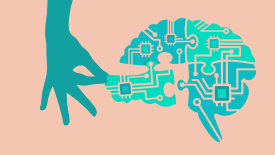You have 1 article left to read this month before you need to register a free LeadDev.com account.
Your inbox, upgraded.
Receive weekly engineering insights to level up your leadership approach.
Estimated reading time: 3 minutes
With the rise of AI, is the role of QA going to evolve with the times or slowly fade into obscurity?
Software development is moving faster than ever. Agile and DevOps have brought shorter sprints, smaller releases, and constant updates. With the addition of AI, the pressure to deliver quickly – without breaking things – has compounded.
However, while AI has increased the speed of delivery, it has not erased complexity. Automations can help, but they can’t catch everything. Edge cases require human judgment, which is where manual QA steps in; spotting the gaps and asking the right questions.
The human aspect of quality assurance
Automations excel at repetitive tasks, but their hurdles are plentiful too: troubles with unpredictability, complex user interactions, and testing edge scenarios are but a few. A human-in-the-loop QA can offset these risks massively.
For instance, in one fraud detection project I was a part of, we used machine learning models trained on historical transaction patterns to flag suspicious activity. At first, everything was working smoothly. High-value transactions were being flagged as expected.
However, during a second round of deeper testing, we noticed that some legitimate high-value transactions were being flagged as fraudulent. Why? The model had learned that high-value transactions during the holiday season were often fraudulent. Therefore, when similar transactions arose, even if valid, they were viewed as suspect. To add another layer of difficulty, our tests did not catch the error, as they had used validation data from the same holiday period.
To fix this, we broadened the test data to include different data sets and re-trained the model on those.
Without manual testing processes here, the issue would never have been caught, and the system would have continued to misallocate transactions, highlighting the importance of manual sifting.
More like this
AI cannot apply business understanding to complex systems
Just as financial institutions require human oversight to interpret massive volumes of data, software development relies on human understanding to make sense of complex application code.
Automated tests can perform thousands of checks, but they can only identify the things they are intended to identify. They cannot adapt to new situations or think creatively.
For example, during a banking project, a new “pay later” feature was released for credit card users. Here, automated tests gave it the green light. Everything looked fine until, during manual testing, it was discovered that the feature was appearing for international users, who weren’t meant to see it.
This happened due to a geo-location logic issue that the automation didn’t catch. A human tester, however, with an understanding of the business rules and user expectations, prevented a costly mistake from reaching customers. This is where human testers excel – able to consider all the context of the application and the wider business needs.
Ability to adapt to rapid changes
As software development shifts, so too do testing requirements. Given the rapid nature of change in tech, automated testing techniques, ironically, are at risk of not keeping pace.
To illustrate this, take this real-world example. During the COVID-19 crisis, we had to roll out an emergency loan feature in our mobile app. While the automation was in place for standard flows – new rules, new features, and new logic came in overnight. It was simply impossible to build an automation for it in such a short time period.
Manual testers came as a blessing. We quickly understood the changes, ran tests flagged issues, and shared feedback, helping solve a precarious situation.
In moments like these, manual testing isn’t a fallback, but rather a key advantage to keeping the wheels turning. When time is short, human judgment and adaptability are hard to beat.

London • June 2 & 3, 2026
Rands, Nicole Forsgren & Matej Pfajfar confirmed
The future of hybrid methods
Manual testing is growing and remains the cornerstone of software testing for all applications. While automation is crucial for handling large test volumes and repetitive tasks, manual testing is still necessary to ensure software quality. By providing the intelligence, creativity, and adaptability that automated systems cannot match, manual testing is evolving to enhance automation rather than replace it.
Ultimately, manual testing remains unaffected. It has and will continue to be an essential part of the software quality assurance process to meet the challenges of the future software landscape.





